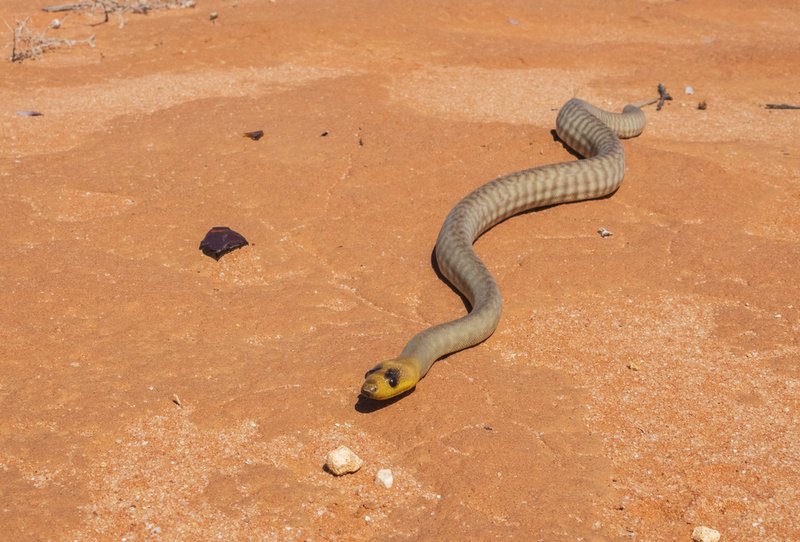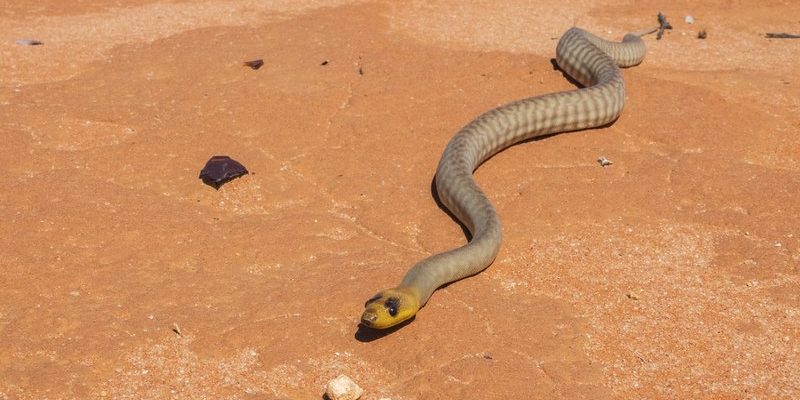
The Woma Python, often known as the Antaresia helmichii, is one of nature’s unique gems found in Australia. Imagine a snake that’s as stunning as it is interesting, with a grace that can make your heart skip a beat. This python isn’t just a feast for the eyes; it’s packed with fascinating traits that make it a favorite among snake enthusiasts and wildlife lovers alike. Its captivating appearance and gentle disposition set it apart from the more notorious members of the python family.
You might picture a python as a giant, fearsome serpent, but the Woma Python is quite the contrary. It’s a medium-sized snake that usually grows to about 4 to 6 feet in length, making it a manageable size for those who admire these reptiles. Their color variations, ranging from rich browns to stunning yellows and blacks, are mesmerizing. Indeed, each Woma Python is like a little piece of art, with patterns that are as intricate as a painter’s brushwork.
Physical Characteristics
When it comes to physical features, the Woma Python is nothing short of spectacular. Their appearance varies significantly based on their habitat, which can be quite extensive across central and western Australia. With a slender build and a smooth, shiny scale texture, these snakes are designed for stealth and grace. You’ll often see them blending seamlessly into their surroundings, thanks to their earthy tones.
A cool fact about Woma Pythons is their unique head shape, which is slightly wider than their neck. This characteristic allows them to exert pressure with precision when capturing prey. Their eyes are also somewhat distinct, featuring a golden hue that glimmers under the sun, adding to their charm. It’s almost as if they have a personality all their own, reflecting curiosity and calmness.
Color Variations and Patterns
The color variations in Woma Pythons are truly astounding. You can find them sporting beautiful combinations of gold, brown, and black, which not only serve as camouflage but also make them a joy to observe. Some breeds even showcase patterns resembling beautiful abstract art—no two snakes are exactly alike! These variations aren’t just for show; they help the snakes to hide from predators and sneak up on their prey.
Habitat and Distribution
Woma Pythons are primarily found in the arid and semi-arid regions of Australia, thriving in habitats that range from grasslands to woodlands. It’s interesting how these snakes have adapted to their environments, showing flexibility in their living conditions. They prefer areas where they can easily hide and hunt, often seeking shelter in burrows or beneath rocks and logs.
One of the reasons the Woma Python is so successful in these environments is their diet, mainly consisting of small mammals and birds. Their ability to adapt their hunting techniques ensures they can find food even in challenging climates. It’s almost like they have their own survival playbook, tailored to the Australian landscape’s demands.
Climate Adaptations
Adapting to such a varied climate is no small feat. The Woma Python has developed strategies to cope with the heat during the day, often becoming more active at night when temperatures drop. This nocturnal behavior helps them to avoid the sweltering sun while still allowing them to hunt effectively. During cooler months, they might even brumate, a hibernation-like state, to conserve energy.
Diet and Hunting Behavior
The diet of a Woma Python primarily consists of small mammals, such as rat species and occasionally birds. These snakes are constrictors, meaning when they catch their prey, they wrap around it and squeeze tightly until it can no longer breathe. This technique is not just effective; it’s also critical for their survival. Imagine them carefully stalking through the underbrush, their smooth scales gliding silently as they await the perfect moment to strike.
What’s fascinating is their method of hunting. Unlike some other pythons, Woma Pythons are known to be active hunters. They won’t always wait in ambush; instead, they’ll actively search for food. This adaptability makes them fantastic hunters in their environment, keeping their diet diverse and their habits interesting.
Feeding Habits in Captivity
If you’re thinking of keeping a Woma Python as a pet, it’s essential to understand its feeding habits. In captivity, they thrive on a diet of appropriately sized rodents, which can be easily acquired. Regular feeding schedules, along with a mix of live or frozen prey, help maintain their health and happiness. Just remember, never feed your snake anything larger than its body width to avoid any potential health problems.
Behavior and Temperament
Woma Pythons are known for their docile and calm demeanor. They tend to be less aggressive than other pythons, making them a popular choice for beginners in reptile keeping. You might be surprised to learn that many of these snakes enjoy being handled, and with regular interaction, they can develop a strong bond with their owners. It’s like having a gentle, scaly companion who’s always ready to explore.
Interestingly, their temperament can vary slightly based on individual personalities. Some Woma Pythons may be more curious and social, while others might prefer to observe from a distance. Regardless of their personality quirks, it’s clear that these snakes have a unique charm that captivates those who encounter them.
Social Interactions
In the wild, Woma Pythons are primarily solitary creatures, but during the breeding season, they exhibit unique social interactions. Males will often compete for females, engaging in wrestling matches that showcase their strength and agility. It’s like a natural dance, showcasing the beauty of their movements while also proving their fitness as potential mates. This aspect of their behavior adds yet another layer to their already fascinating lives.
Conservation Status
The conservation status of the Woma Python may vary in different regions, but it’s essential to recognize their role in the ecosystem. As a non-aggressive predator, they help regulate small mammal populations, which is crucial for maintaining balance in the food web. Unfortunately, habitat loss and human encroachment are significant threats to their populations.
In response to these challenges, various conservation efforts are underway to protect Woma Python habitats. Organizations are working to create awareness about their importance and implement measures to preserve their environments. You can feel good knowing that those who love these unique snakes are also advocating for their future and recognizing the critical role they play in the ecosystem.
Human Interaction and Education
Education about the Woma Python is vital for fostering appreciation and understanding of these reptiles. Many zoos and wildlife organizations provide educational programs that highlight their ecological role and promote conservation efforts. By learning about these snakes, people can develop a greater respect for wildlife and an understanding of the delicate balance within ecosystems. It’s a reminder that every creature, no matter how small, plays a part in the story of our planet.
Interesting Facts About Woma Pythons
| Common Name: | Woma Python |
| Scientific Name: | Antaresia helmichii |
| Length: | 4 to 6 feet |
| Weight: | 5 to 10 pounds |
| Habitat: | Arid and semi-arid regions |
| Diet: | Small mammals and birds |
| Lifespan: | 15 to 20 years in captivity |
FAQ
What is the lifespan of a Woma Python in captivity?
In captivity, Woma Pythons can live between 15 to 20 years, provided they receive proper care and nutrition. Their lifespan can be influenced by factors such as diet, habitat conditions, and overall health. If you’re planning to keep one as a pet, it’s crucial to create a suitable environment and offer a balanced diet to ensure they thrive throughout their lives.
Are Woma Pythons good pets for beginners?
Absolutely! Woma Pythons are often regarded as excellent pets for beginners due to their calm demeanor and manageable size. They’re generally docile and tend to tolerate handling well, making them a great choice for those new to reptile ownership. However, it’s still important to research their care requirements and ensure you’re prepared for the responsibility of pet ownership.
How can I tell if my Woma Python is healthy?
Monitoring your Woma Python’s health involves observing its overall behavior and appearance. A healthy snake will be active, alert, and have a smooth, shiny appearance. Regular feeding and shedding without signs of distress or illness are also indicators of a healthy snake. If you notice any sudden changes in behavior, appetite, or physical condition, it’s best to consult a veterinarian experienced in reptile care.
Where can I find Woma Pythons for sale?
Woma Pythons can be found for sale through reputable breeders, pet shops, and sometimes at reptile expos. It’s crucial to choose a reliable source to ensure you’re getting a healthy and ethically bred snake. Be sure to ask questions about the snake’s background, health, and care requirements before making a decision.
Do Woma Pythons require special care compared to other snakes?
While Woma Pythons have similar care requirements to other snakes, they do have specific needs. They require a suitable habitat that offers both hiding spots and climbing opportunities, along with a basking area to regulate their body temperature. Regular check-ins on humidity and temperature levels are essential to maintain their health. As with any pet, understanding their unique needs will help you provide the best care.
How do Woma Pythons breed?
Woma Pythons breed in the warmer months, usually between September and November in Australia. Males will engage in courtship rituals, which include wrestling and rubbing against females. After mating, females lay clutches of 5 to 15 eggs, which they incubate until they hatch. This fascinating process showcases the commitment these snakes have to reproduction and the continuation of their species.
Are Woma Pythons endangered?
Woma Pythons are not currently classified as endangered, but they face threats from habitat destruction and urbanization. Conservation efforts are essential to help protect their habitats and ensure they continue to thrive in the wild. Awareness programs and habitat protection initiatives are crucial in keeping their populations stable and healthy.
What should I feed my Woma Python?
In captivity, Woma Pythons should be fed a diet primarily consisting of appropriately-sized rodents, such as mice or rats. It’s important to choose prey that isn’t larger than the snake’s body width to avoid any feeding complications. Regular feeding schedules will help maintain their health, and offering a mix of live or frozen prey can keep their diet interesting.
Do Woma Pythons bite?
While Woma Pythons are generally known for their calm temperament, they can bite if they feel threatened or mishandled. It’s vital to approach them with confidence and respect, ensuring they feel secure during handling. With proper care and interaction, you can significantly reduce the chances of a bite, making handling a positive experience for both you and your snake.
Can Woma Pythons be kept with other snakes?
It’s generally not recommended to keep Woma Pythons with other snakes, as this can lead to territorial disputes and stress. Each snake has its own needs and behavior, and housing them together can create an environment prone to conflict. If you’re considering multiple snakes, it’s best to provide separate enclosures to ensure their safety and well-being.

